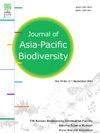蒙古獐牙菜(龙胆科)叶绿体全基因组
IF 0.7
Q4 BIODIVERSITY CONSERVATION
引用次数: 0
摘要
獐牙菜(Swertia obtusa Ledebour)是一种多年生草本植物,分布在中国(新疆)、哈萨克斯坦、蒙古和俄罗斯。在本研究中,我们利用高通量测序技术对圆叶霉叶绿体全基因组进行了测序。该基因组全长153,874 bp,由一对反向重复序列(IRs, 25,855 bp)、一个大的单拷贝区(LSC, 83,843 bp)和一个小的单拷贝区(SSC, 18,321 bp)组成。基因组有113个独特的基因,包括4个核糖体RNA (rRNA), 30个转移RNA (tRNA)和79个蛋白质编码序列基因。共发现42个简单重复序列(SSRs),主要位于基因间间隔区。分析结果显示,有26255个密码子被蛋白质编码基因的反密码子识别。根据獐牙菜的叶绿体基因组,将獐牙菜归入獐牙菜亚属。本文章由计算机程序翻译,如有差异,请以英文原文为准。
The complete chloroplast genome of Swertia obtusa (Gentianaceae) in Mongolia
Swertia obtusa Ledebour is a perennial herb distributed in China (Xinjiang), Kazakhstan, Mongolia, and Russia. In this study, we sequenced the complete chloroplast genome of S. obtusa using high-throughput sequencing. The length of this genome was 153,874 bp, consisting of a pair of inverted repeats (IRs, 25,855 bp), a large single-copy region (LSC, 83,843 bp), and a small single-copy region (SSC, 18,321 bp). The genome had 113 unique genes, consisting of 4 ribosomal RNA (rRNA), 30 transfer RNA (tRNA), and 79 protein coding sequence genes. A total of 42 simple sequence repeats (SSRs) were discovered, primarily in the intergenic spacer region. The analysis revealed 26,255 codons recognized by the anticodons of protein coding genes. Swertia obtusa was classified within the subgenus Swertia based on its entire chloroplast genome.
求助全文
通过发布文献求助,成功后即可免费获取论文全文。
去求助
来源期刊

Journal of Asia-Pacific Biodiversity
Agricultural and Biological Sciences-Insect Science
CiteScore
1.70
自引率
12.50%
发文量
94
审稿时长
27 days
期刊介绍:
The Journal of Asia-Pacific Biodiversity (previous title was Journal of Korean Nature) is an official journal of National Science Museum of Korea (NSMK) and Korea National Arboretum (KNA). The scope of journal is wide and multidisciplinary that publishes original research papers, review articles, as well as conceptual, technical and methodological papers on all aspects of biological diversity-its description, analysis and conservation, and its application by humankind. This wide and multidisciplinary journal aims to provide both scientists and practitioners in conservation theory, policy and management with comprehensive and applicable information. However, papers should not be submitted that deal with microorganisms, except in invited paper. Articles that are focused on the social and economical aspects of biodiversity will be normally not accepted.
 求助内容:
求助内容: 应助结果提醒方式:
应助结果提醒方式:


